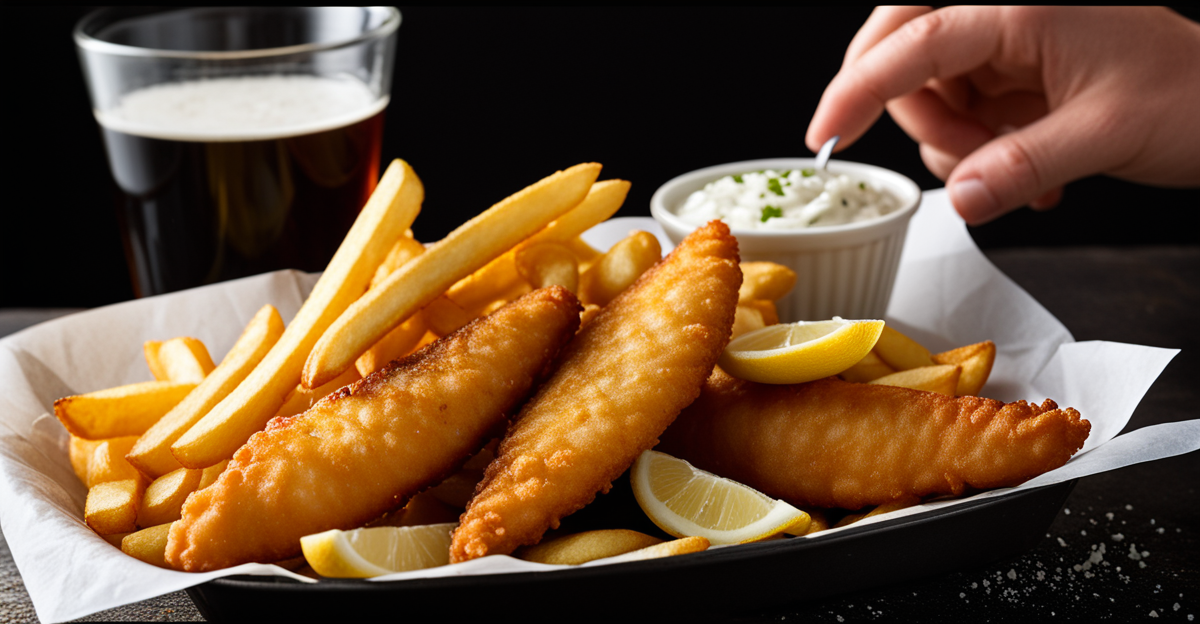Selecting the Right Fish
When it comes to choosing fish for the classic dish of fish and chips, fish selection plays a critical role in determining the final taste and texture. Popular types of fish for this iconic meal include cod, haddock, and hake, known for their flaky texture and mild flavor. Cod is often celebrated for being the best choice for fish and chips due to its firm texture, which holds up well in frying.
Freshness is paramount; when assessing freshness criteria, look for bright eyes, firm flesh, and a clean aroma–all indicators of a freshly sourced catch. To ensure the best quality, consider purchasing from local fishmongers known for sustainable practices, thereby supporting responsible fishing methods and protecting marine ecosystems. Sustainability is not just a buzzword; it benefits both the environment and your conscience, ensuring future generations can enjoy these delicious varieties. By understanding your fish selection and considering sustainability, you’re setting the stage for a delightful and environmentally friendly meal.
In the same genre : What Unique Flavors Define Traditional UK Dishes?
Preparing the Perfect Batter
Crafting the ideal batter is essential for creating the crispy exterior that makes fish and chips so irresistible. A traditional batter recipe often includes simple ingredients like flour, water, and a leavening agent, usually baking powder. It’s this combination that contributes to the light and airy texture sought after in a crispy batter.
Achieving Crispy Batter
To ensure the batter’s crispiness, maintaining the correct batter consistency is crucial. A batter that’s too thick can become heavy, whereas one that is too thin may not coat the fish adequately. The optimal texture should be smooth and coat the back of a spoon seamlessly. Adding carbonated water or beer can also help achieve a lighter texture by introducing additional bubbles, enhancing crispness when fried.
Also to read : What are the traditional methods for making British bangers and mash?
For those seeking alternatives, consider experimenting with gluten-free flours such as rice flour or chickpea flour. These options can provide excellent results without compromising the desired crunchiness. Techniques like chilling the batter before use can also contribute to a more elastic and crispy coating, as the temperature contrast between the cold batter and hot oil aids in crisping.
Tailoring the batter to your preferences while keeping these techniques in mind will guide you in creating a batter that complements the fish perfectly.
Mastering the Frying Process
When it comes to frying fish for that perfect fish and chips, understanding the right frying techniques is crucial. Start by selecting a suitable oil, such as vegetable or peanut oil, known for their high smoking points, which are ideal for achieving a crispy exterior without burning. The recommended oil temperature is between 350°F and 375°F, which ensures a golden color while preventing the oil from becoming absorbed into the fish.
Step-by-Step Frying Process
- Preheat your oil to the proper temperature, using a kitchen thermometer to maintain accuracy.
- Once heated, gently lower the battered fish into the oil, avoiding overcrowding the pan to ensure even cooking.
- Fry the fish for approximately 5 to 7 minutes, turning occasionally until both sides are evenly golden and crispy.
Consistency is key, so monitor the temperature throughout the process to prevent fluctuations which can lead to soggy or undercooked results. If you encounter issues like batter not adhering to the fish, consider adjusting the batter consistency or ensuring the fish is well-dried before coating.
To troubleshoot common frying issues, remember that maintaining a stable oil temperature is essential; too low, and the food absorbs too much oil, too high, and it burns. Through the careful application of these frying techniques, you can master the art of frying and enjoy perfectly cooked, deliciously crispy fish every time.
Crafting the Chips
In the art of making fish and chips, the humble chip often gets overshadowed by its aquatic partner. However, the right chips preparation can elevate your dish. It begins with selecting the best potatoes. Starchy varieties like Maris Piper or Russet are ideal, thanks to their high starch content and low moisture, which promise crispy exteriors and fluffy interiors.
Preparing the Potatoes
The journey to perfect fries entails more than just picking the right spud. Start by cutting the potatoes into uniform pieces to ensure even cooking. Next, soak them in cold water for at least 30 minutes. This step removes excess starch, preventing chips from sticking together and turning out soggy.
Cooking the Chips
After drying the soaked potatoes thoroughly, it’s time for the double-frying method. Fry them first at a lower temperature to cook the interior, then again at a higher temperature for that coveted golden crunch. Aim for an initial frying temperature of about 325°F, followed by a second at 375°F until the chips are a delightful golden-brown. Mastering this technique ensures your homemade chips rival any pub’s offering.
Seasoning and Presentation
Once you’ve mastered the crispy fish and the perfect fries, the next focal point is seasoning choices. Salt is indispensable, enhancing the natural flavors of your dish. Some may prefer a sprinkle of malt vinegar, which adds a tangy zing, complementing the fish and cutting through any oiliness. Alternatively, lemon juice can be used for a fresh, citrusy twist.
Serving Suggestions
Creative serving suggestions can elevate the dining experience. Consider pairing your fish and chips with traditional sides like mushy peas or a tartar sauce. Adding a fresh salad could also bring a refreshing contrast, balancing the fried components.
Plating Tips
For plating, take cues from restaurant-style presentations. Use newspaper or greaseproof paper for a traditional touch or modern white plates to emphasize the golden colors of your fish and chips. Neatly arrange the chips and fish side by side, and garnish with fresh herbs like parsley for a pop of color. By optimizing your seasoning and presentation, you can transform this classic dish into a culinary masterpiece.
Potential Pitfalls and Solutions
Creating the perfect fish and chips can come with its own set of challenges, but understanding these common mistakes can lead you to culinary success. One frequent issue in frying fish is the batter not adhering properly. This can be addressed by ensuring the fish is thoroughly dried and the batter is at the right consistency. Testing a small piece of fish or chip can help in adjusting the batter before committing to the entire batch.
Another typical challenge is achieving the perfect oil temperature. If the oil is too hot, the fish might burn on the outside while remaining undercooked inside. Conversely, oil that’s not hot enough will result in soggy, greasy fish. Using a thermometer to maintain an oil temperature between 350°F and 375°F ensures crispy perfection.
Chips preparation can encounter pitfalls too. Cutting potatoes unevenly results in chips that cook at different rates. Consistent size and soaking potatoes in cold water to remove excess starch can prevent chips from sticking and ensure they turn crispy golden.
For those looking to avoid gluten, a significant pitfall could be finding gluten-free batter recipes that still achieve the desired crispness. Replacing traditional flour with rice or chickpea flour is a viable solution that can also cater to dietary preferences.
Incorporating these troubleshooting tips will not only enhance your confidence but also ensure a consistent, delicious outcome with every fish and chips endeavor.




